Many bird lovers agree that seeing different types of eagles is the highlight of any birdwatching expedition, but how many eagle types are there?
There are roughly 71 different types of eagles globally. The article below examines these majestic birds’ distributions, habitats, habits, and other interesting facts.
While many of us gaze into the sky to try and spot the creature calling majestically, we often don’t know what we’re looking at.
So if you’ve got a keen interest in predatory birds and would love to learn more about the various types of eagles, this article is for you.
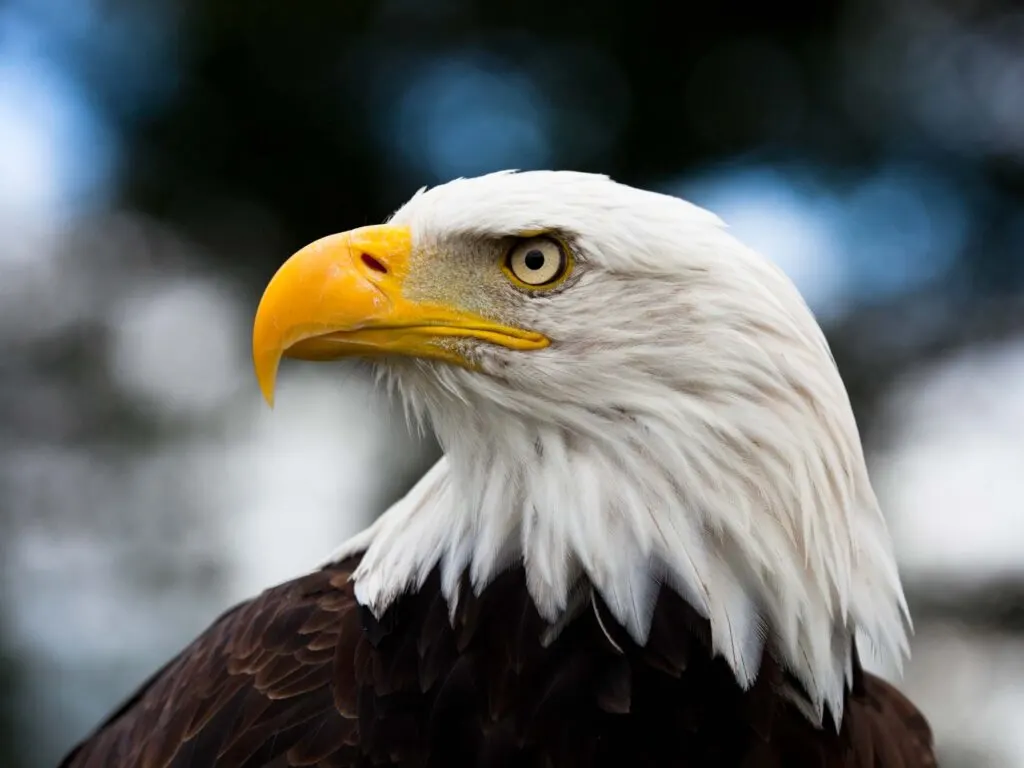
What Is An Eagle?
Eagles are among the largest birds of prey that belong to the Accipitridae family. These types of birds include hawks, ospreys, and kites and encompass roughly 254 different species.
They are vertebrate animals that belong to the Aves class under the Accipitriformes order.
Eagles have a global distribution, aside from Antarctica. However, most eagle species are in Africa and Eurasia (Europe and Asia).
The Integrated Taxonomic Information System (ITIS) lists the 71 different types of eagles under 22 genera.
These genera are Aquila, Circaetus, Dryotriorchis, Eutriorchis, Geranoaetus, Haliaeetus, Harpia, Harpyhaliaetus, Harpyopsis, Hieraaetus, Icthyophaga, Ictinaetus, Lophaetus, Lophotriorchis, Morphnus, Nisaetus, Pithecophaga, Polemaetus, Spilornis, Spizaetus, Stephanoaetus, and Terathopius.
Note taxonomy changes from time to time. As researchers discover new evidence, they split and combine genera accordingly.
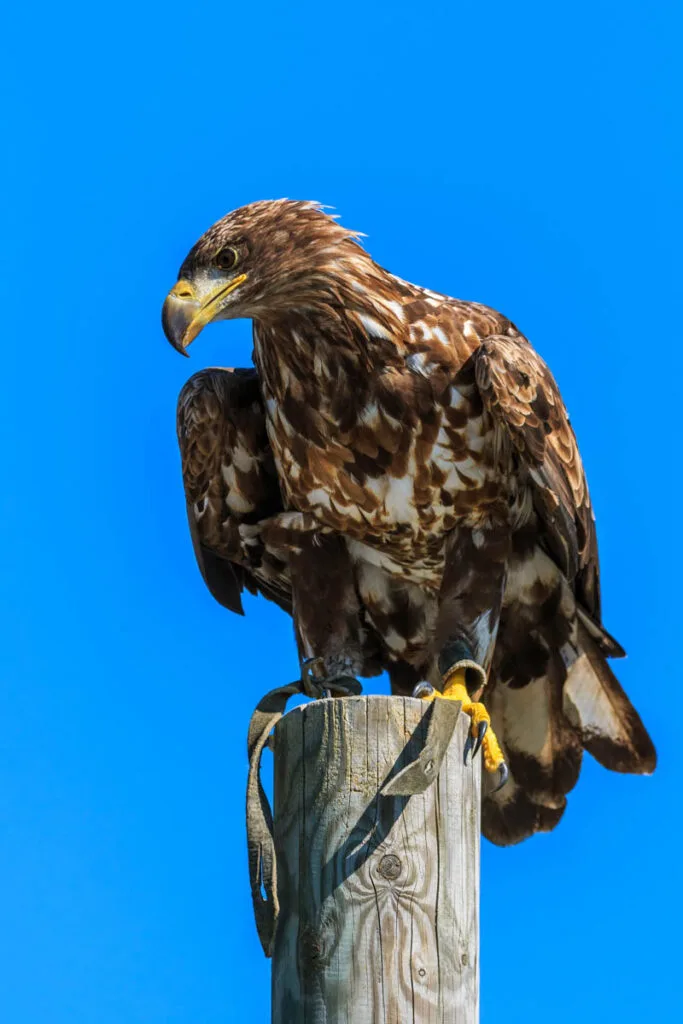
What Makes An Eagle: Shared Characteristics
Eagles don’t belong to a single genus because the name “eagle” is a classification/collective name for birds large and strong enough to catch vertebrate prey roughly 20 inches long. Birds in the Aquila genus are often called “true eagles.”
The various types of eagles share specific characteristics, separating them from the other members of the Accipitridae family.
Eagles are large birds of prey (larger than hawks) with large feet, “heavy” bodies, and big, hooked beaks. Most eagles are diurnal hunters who soar on long, broad wings at high altitudes.
Eagles have a “brow” made up of a bony projection, and they have yellow, red, or hazel eyes and keen vision, which they use to locate prey far below. Eagles are fully feathered, and some have crests.
Most eagles are too “bulky” to catch flying prey. Instead, they overpower animals on the ground (or in water). Upon catching their prey, eagles usually decapitate the hapless victim.
Eagles serve a vital role as apex predators, assisting in population control. Eagles mate for life (monogamous) and return annually to use the same nest (called an eyrie) for breeding.
These nests are usually built in inaccessible places, including massive trees and cliff faces.
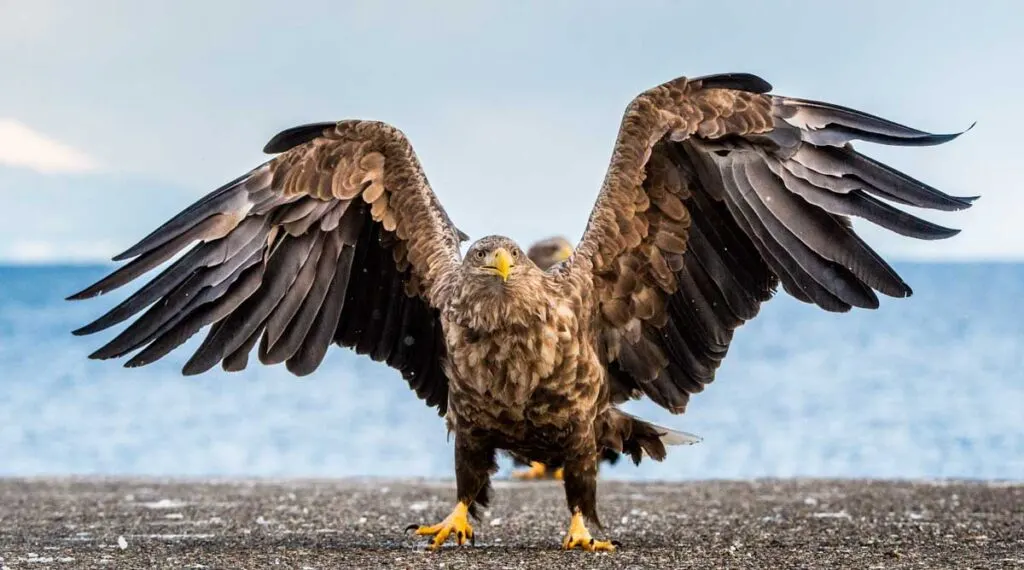
Eagles Types
The various types of eagles are divided into four groups (often referred to as subfamilies) according to similar characteristics.
There is still some debate about what the subfamilies should entail, and some scientists divide the eagles between Circaetinae and Buteoninae. Let’s learn more about the types of eagles.
Subfamily Aquilinae Booted Eagles, Buzzard-Eagles, and Hawk-Eagles
These types of eagles are often referred to as “true eagles,” They include Aquila, Geranoaetus, Hieraaetus, Ictinaetus, Lophoaetus, Lophotriorchis, Nisaetus, Polemaetus, Spizaetus, and Stephanoaetus.
The common characteristic of this subfamily is that all eagles have “boots,” feathers down their legs to their feet.
Subfamily Circaetinae: Snake Eagles And Bateleur
These types of eagles have an aptitude and preference for catching snakes. The genera in this subfamily include Circaetus, Dryotriorchis, Eutriorchis, Spilornis, and Terathopius.
Many of these birds are medium-sized and often occur in semi-deserts, deserts, and forests (close to their food). They are widespread but are absent from Antarctica and South America.
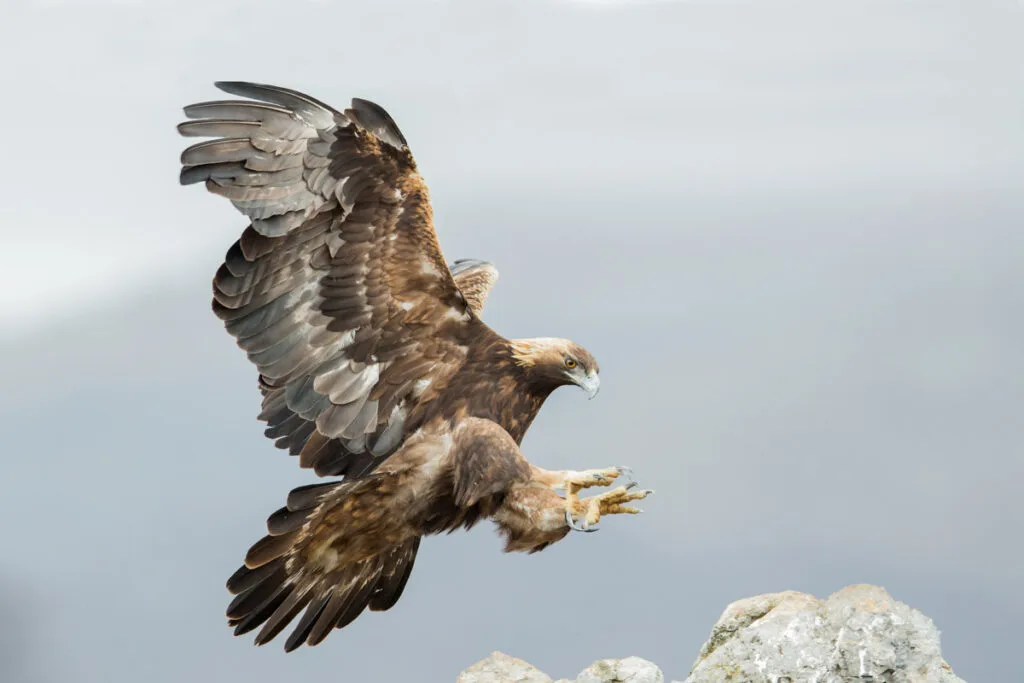
Subfamily Haliaeetinae: Fish And Sea Eagles
Haliaeetus and Icthyophaga are the two genera in this subfamily. These types of eagles are excellent anglers.
They generally occur around water bodies like the coast, lakes, rivers, wetlands, etc., and are some of the largest eagles.
Subfamily Harpiinae: Harpy Eagles
Although this group is not hard and fast (researchers constantly debate which eagle belongs where), these types of eagles are usually large, powerful, forest-inhabiting species, genera in this subfamily include Buteogallus, Harpia, Harpyosis, Morphnus, and Pithecaphaga.
Did you know? Of all the collective nouns for animals, the names for groups of birds are the most interesting ones. A group of eagles is called a convocation of eagles!
20 Different Types of Eagles
Below we’ll investigate some noteworthy eagle species in more detail divided by subfamily.
Booted Eagle Types
Bald Eagle (Haliaeetus leucocephalus)

The most famous eagle in North America and the national emblem of the US since 1782, the bald eagle, has a large, powerful body and large head with a long, hooked bill.
They range in length from 27.9 to 37.8 in and weigh between 6.61 and 13.89 lbs.
Bald eagles are easily recognizable in flight with their broad, straight wings, which average 6.69 ft (large birds have a wingspan of up to 8 feet).
They have a white feather on their head and tail, yellow bill and legs, and dark brown bodies and wings. Bald eagles don’t have “booted” legs.
Bald eagles live between 20 and 30 years. Their distribution is from the Arctic desert (the second largest desert in the world) in Canada and Alaska to northern Mexico, where they soar gracefully above water bodies (lakes, marshes, rivers), coastlines, and forests (nesting).
Their diet consists of various fish species (primary). They also take rabbits, snakes, turtles, waterfowl, other small animals, and carrion.
Bald eagles often “poach” fish from other birds (like ospreys) and even people. Unsurprisingly, they are apex predators in their range.
These eagles occasionally float and “paddle” with their wings.
Their conservation status is “least concern.”
Golden Eagle (Aquila chrysaetos)
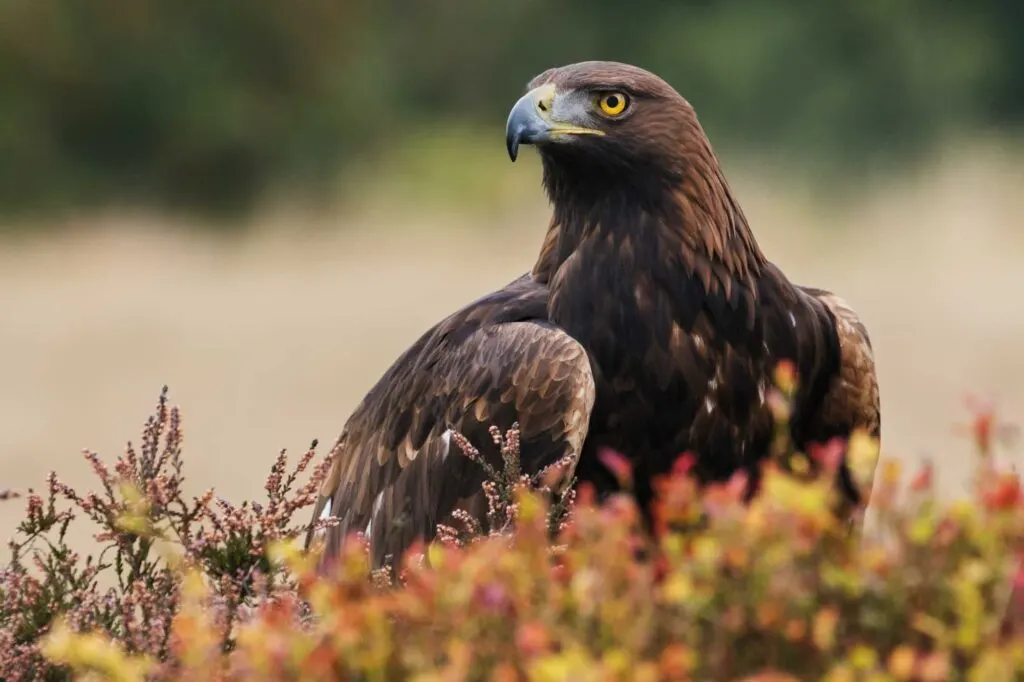
Golden eagles are found throughout Europe, North Africa, Asia, and North America, including the Chihuahuan Desert, a Mexico-US desert. As such, they are among the most widely spread eagles.
When diving, golden eagles can drop very fast, reaching speeds of up to 200 miles per hour, making them one of the fastest birds in the world.
These predatory birds hunt ground squirrels, rabbits, mountain goats, and prairie dogs, among other small mammals.
Golden eagles are large raptor birds, reaching up to 40 inches long. Their wings are broad, and the wingspan is about 7 feet 8 inches.
Eastern Imperial Eagle (Aquila heliaca)
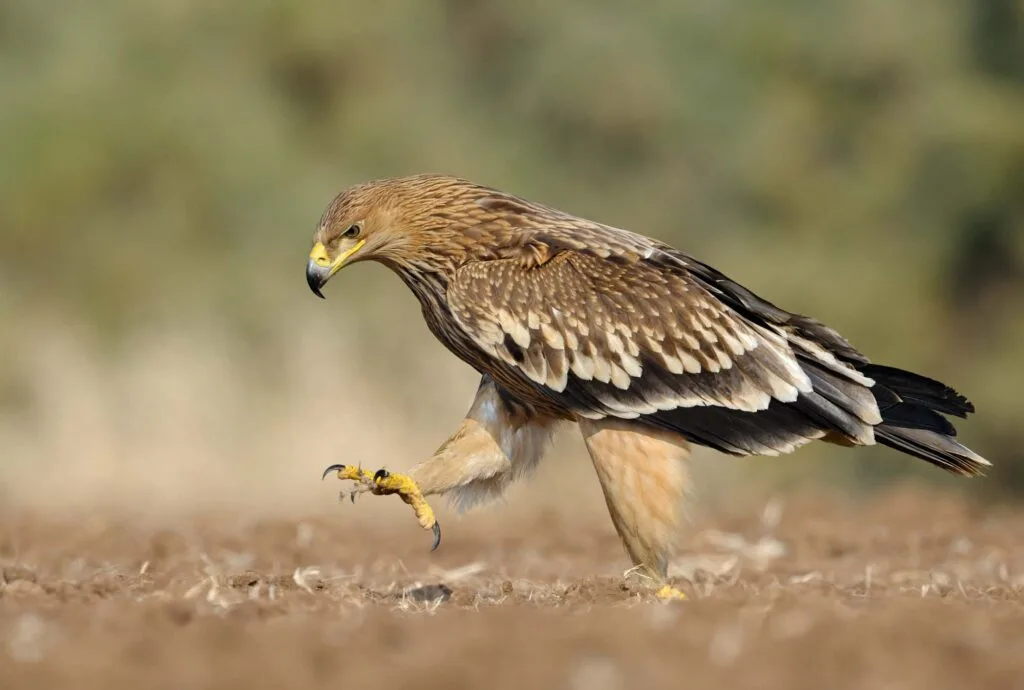
The eastern imperial eagle is a medium-sized eagle (for the genus) with a dark brown appearance. They have a yellow bill (cere) and feathered legs with yellow feet.
They also have white spots on their shoulders and light brown heads.
Reaching between 26.77 and 45.43 in, these eagles are reputed to live up to 56 years.
They are a migratory eagle type that breeds in southeastern Europe and West and Central Asia while wintering in northeastern Africa, the Middle East, and South and East Asia.
These eagles frequent Taiga forests, open and enclosed woodlands, wetlands and rivers, steppes, and forest-steppe mosaics.
Although these eagles have 5.77 to 7.09 ft wingspans, they ambush most of their prey on the ground by “perch hunting” from low branches.
Weighing between 5.4 and 10 lbs., these eagles overpower small mammals (rabbits and susliks/ground squirrels), reptiles, and other birds. They also eat carrion.
Listed as vulnerable, these eagles attack humans who get too close to their nests (it is rare, though).
Wedge-Tailed Eagle (Aquila audax)
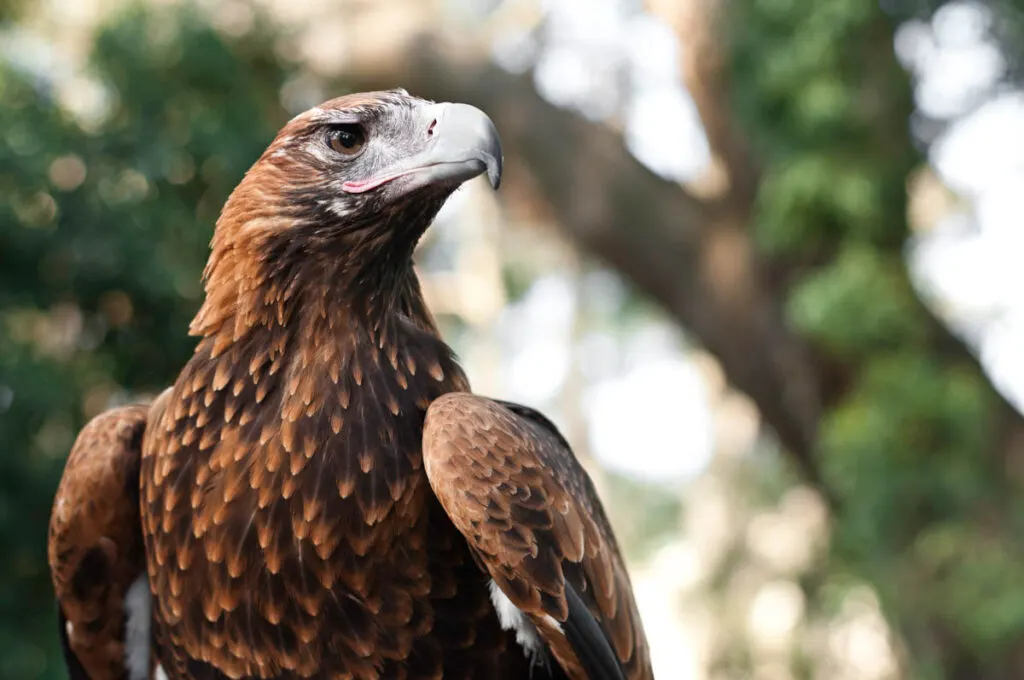
The wedge-tailed eagle is another “true eagle” listed as “least concern.” They have a diagnostic wedge-shaped tail, dark brown bodies, feathered legs, and off-white feet.
They have a cream to pale pink, large, hooked bill, brown eyes, and weigh 7.05 to 11.68 lbs.
These 34.25 to 41.34 in. eagles occur in Australia, Southern New Guinea, and Tasmania, where they inhabit wooded/forested land and open country from sea level to alpine zones on mountains.
They avoid densely forested areas where their 7.55 ft wingspan is hindered, preferring to soar at altitudes of up to 1.24 miles for 90 minutes.
The wedge-tailed eagle’s diet consists of carrion, birds, lizards, rabbits, hares, and other small mammals, which they attack on the ground, killing them with their powerful talons.
Occasionally these eagles collaborate to hunt large prey, including kangaroos. They can carry up to 11 pounds while flying, making them one of the strongest birds.
Tawny Eagle (Aquila rapax)
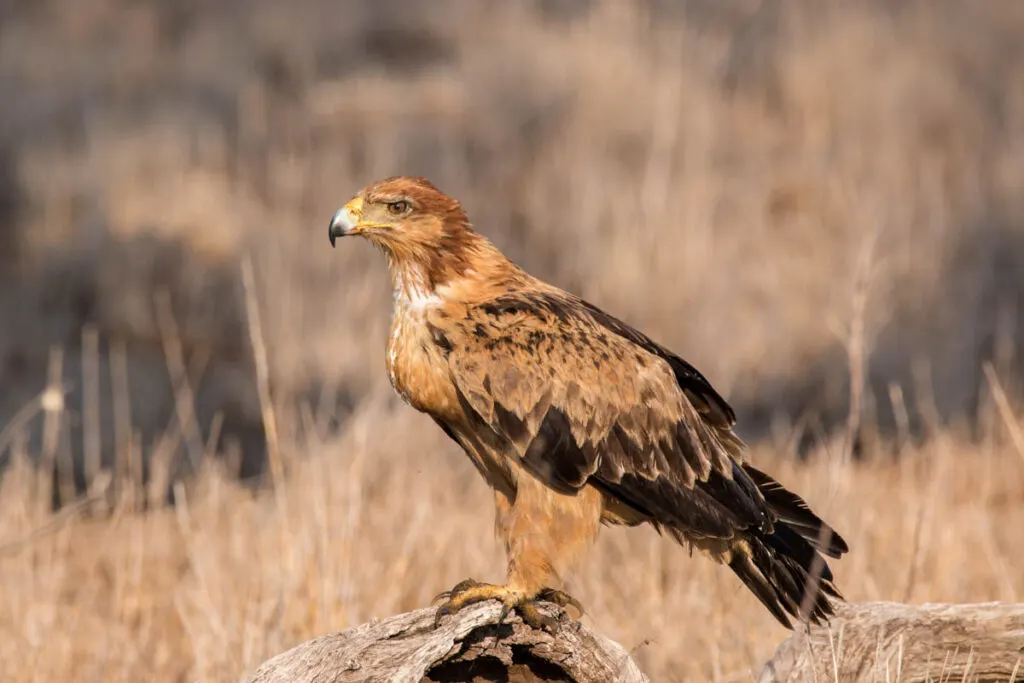
Tawny eagle coloration varies from dark to light brown. They have dark (black) tails, flight feathers, and light-bared wings, while some have a red-brown color.
They have brown eyes and a yellow bill and grow between 25.59 to 28.35 in. long while weighing 4.3 to 5.51 lbs. These eagles frequently fly on thermals with their 5.64 to 6.07 ft wings.
Their distribution includes Africa, Mongolia to India, and Romania to Southern Russia, where they occupy deserts, mountainous regions, open grassland and savannah, and steppes (including cultivated areas).
Their diet includes carrion, insects, small birds, and small mammals. They scavenge from humans more than any other eagle.
Tawny eagles are often in groups of up to 20 birds and are listed as “least concern.”
When agitated, tawny eagles may emit a crow-like “caw.”
Verreaux’s Eagle (Aquila verreauxii)
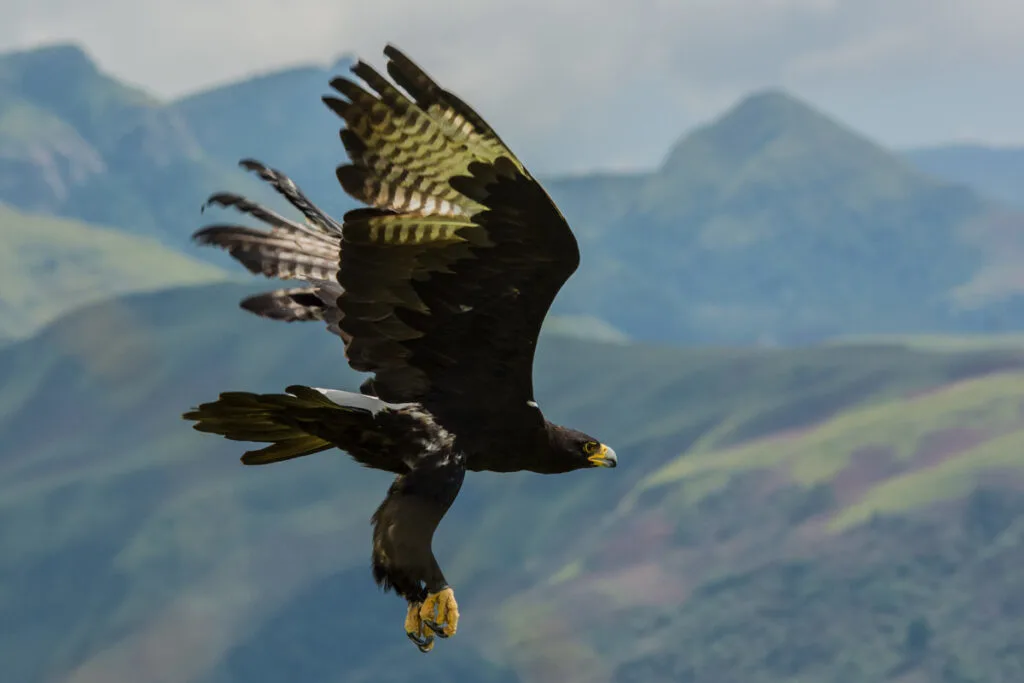
Named after the French 18th-century naturalist Jules Verreaux, the Verreaux’s eagle is also called the black eagle due to its mostly black body. Ironically, they are close relatives of the golden eagle.
They have a distinctive white “V” across the back and rump. They are massive birds (27.56 to 31.50 in and weighing 2.2 to 3.5 lbs. ) with large, yellow bills and feathered legs with yellow feet.
These eagles occur throughout Africa, from Eritrea in the north to South Africa and the Arabian peninsula, in mountains and hills, dry savannah, desert, high rainfall areas, and woodlands.
Their primary prey species are rock hyraxes; however, they eat other small mammals, birds, and reptiles. They frequently soar high on 4.86 to 6 ft wings, looking for prey.
Their conservation status is “least concern.”
African Crowned Eagle (Stephanoaetus coronatus)
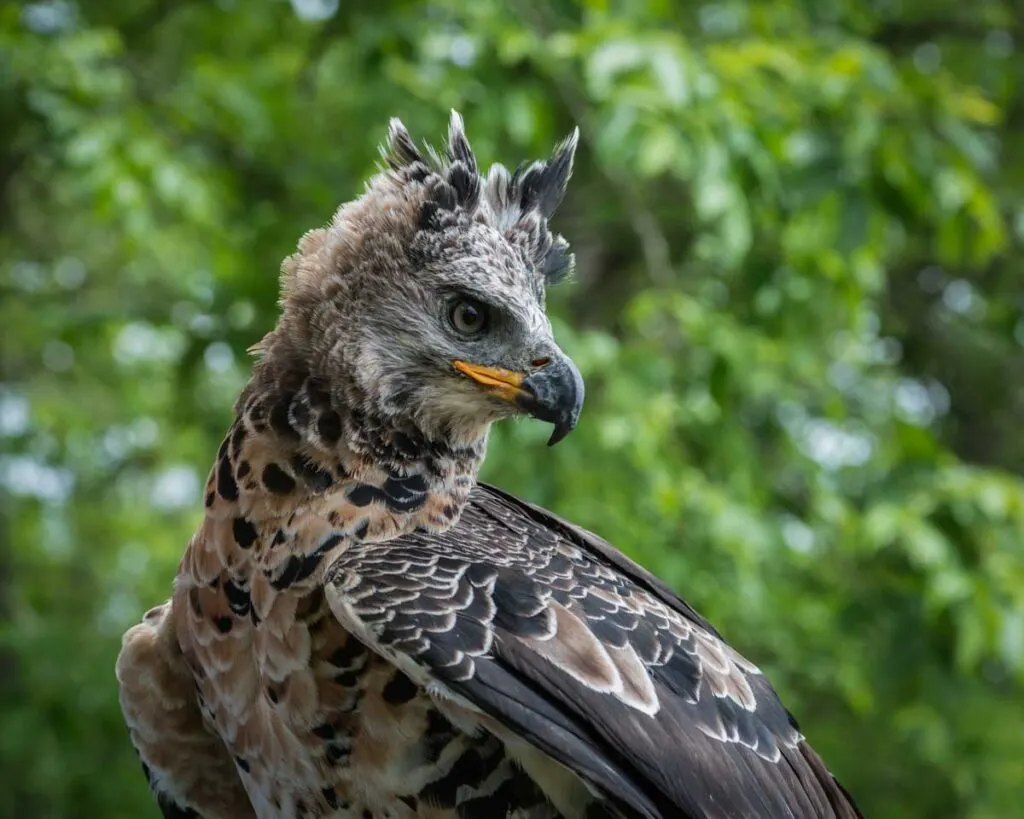
The African crowned eagle is a large, heavy-bodied eagle with shorter, broad wings. They have thick legs and long talons.
They average between 31 and 39 in, weigh between 6 and 10 lbs., and have wingspans of 5 to 5.9 ft.
Crowned eagles have dark brown heads and sport white-tipped crest feathers. They have black-barred cream or red-brown breasts and black wings that are red-brown underneath.
These birds live up to 15 years and are widespread in (southeastern and central) sub-Saharan Africa.
They perch on trees close to watering holes and ambush prey, including feral cats, rats, mongooses, monitor lizards, snakes, and small antelope (hunting prey up to 44 pounds (4 times their weight)). Their powerful talons are deft at snapping the victim’s spine.
Sometimes male/female pairs hunt monkeys together, with the male flying high and the female just above the canopy.
You’ll see these near-threatened birds in tall woodland forests, rainforests, savannas, grasslands, and mountains.
Although the crowned eagle dives on prey at breakneck speed (100 mph), they only need 20 feet to “hit the brakes.”
Martial Eagle (Polemaetus bellicosus)
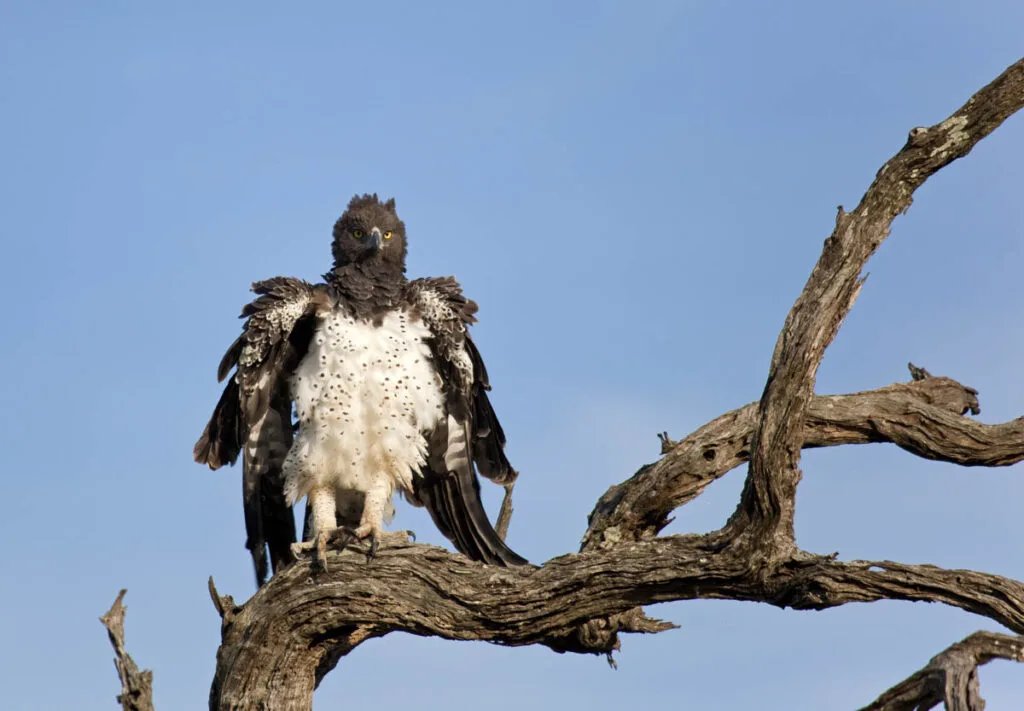
The largest African eagle, the martial eagle, has a short dark crest and brown upper parts. They have black/brown-spotted, white underparts and feathered legs with blue-gray toes.
They also have bars on their short tails and long, curved black bills. Their long wings (6.17 to 8.53 ft) point slightly at the tips and are dark with bars underneath.
These eagles weigh up to 14 lbs and grow between 30.7 and 37.8 in.
Widespread across sub-Saharan Africa, they are absent from most of Central Africa and other thick forests, as they prefer savanna, steppe, semi-desert, and scrubby woodlands from sea level to 9843 feet.
Soaring at high altitudes, they make a controlled dive and strike the victim with their long legs and powerful claws.
Martial eagles prey on medium-sized mammals, birds, and lizards, including Cape hares, francolins, genets, mongooses, and rock hyraxes.
These endangered birds live between 12 and 14 years.
The martial eagle is strong enough to (reputedly) knock over a full-grown man, and on rare occasions, martial eagles may kill prey up to 77 lbs.
Booted Eagle (Hieraaetus pennatus)
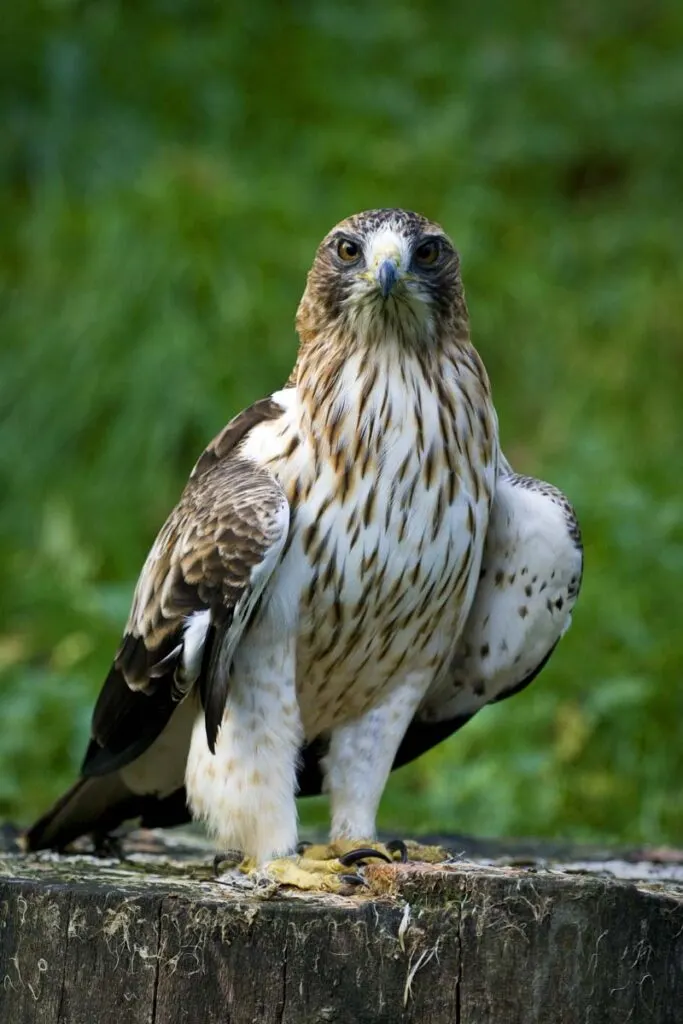
Booted eagles are medium-sized birds (17.72 to 21.65 in and 1.57 to 2.15 lbs.) that resemble “buzzards.”
They have long black primary feathers, a long square tail, and feathered legs. There are two color varieties.
The less common dark form has a pale head and neck with darker streaks and a white forehead.
While most of the body is dark brown, the tail is pale. The light /pale form has white legs and a lighter underside. The back is gray, and the head is faded rufous.
Booted eagles are a migratory species that winters in Africa and India. Their distribution includes Southern Europe, North Africa, and Southern Asia (including Japan), where they inhabit forests and open lands in mountainous regions, slopes, and hills in areas up to 9,843 feet.
They regularly hunt in open areas where they soar (on 3.61 to 4.27 ft wings) and dive onto prey.
They also perch and wait for prey to walk past, which includes lizards, small birds, rabbits, and other small mammals. These eagles poach eggs from nests.
Their conservation status is “least concern.”
Black Hawk-Eagle (Spizaetus tyrannus)
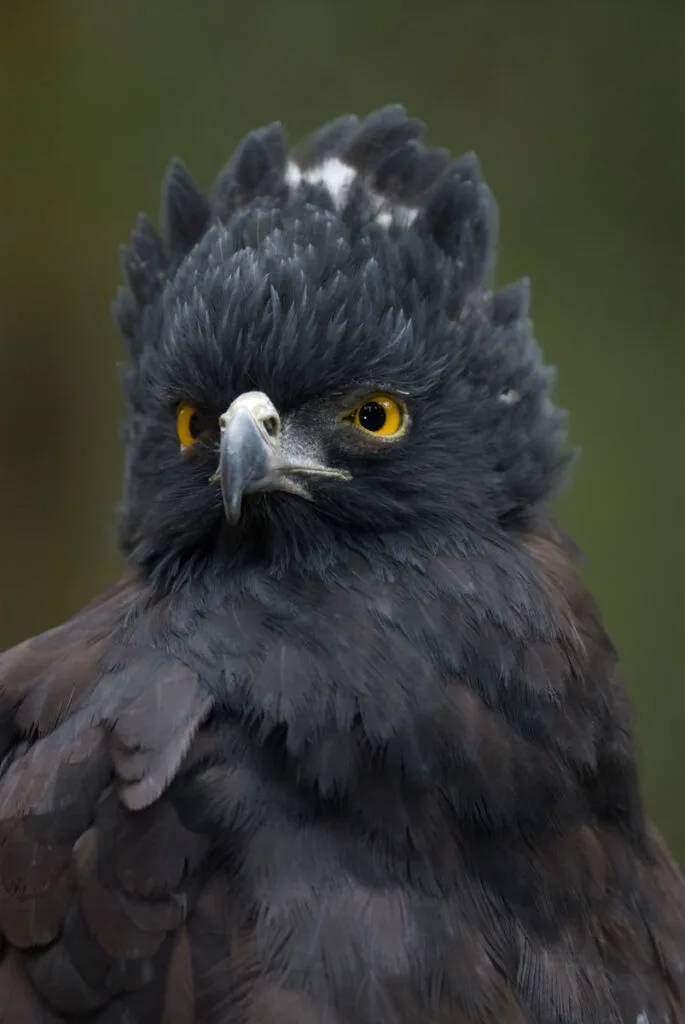
Black hawk eagles are black overall, with white “checkers” on their underwings and a banded tail.
They also have short crests, feathered legs, and yellow feet. Reaching between 23 to 28 in, these are relatively light eagles (2 to 2.9 lbs.) with a wingspan of 4.58 ft.
The crest around their heads is called a “facial disk,” It assists in focusing sound waves to the eagle’s ears (similar to cupping your hands behind your ears). This enhanced sound helps black hawk eagles hunt.
Their distribution includes Southern Mexico through Central and South America to eastern Peru, where they inhabit lowland tropical forests (gallery, humid, and moist) below 6562 feet and forest edges.
Often observed soaring, these eagles prey on small mammals like bats, marmosets, opossums, squirrels, and squirrel monkeys.
Their conservation status is “least concern.”
Blyth’s Hawk-Eagle (Nisaetus alboniger)
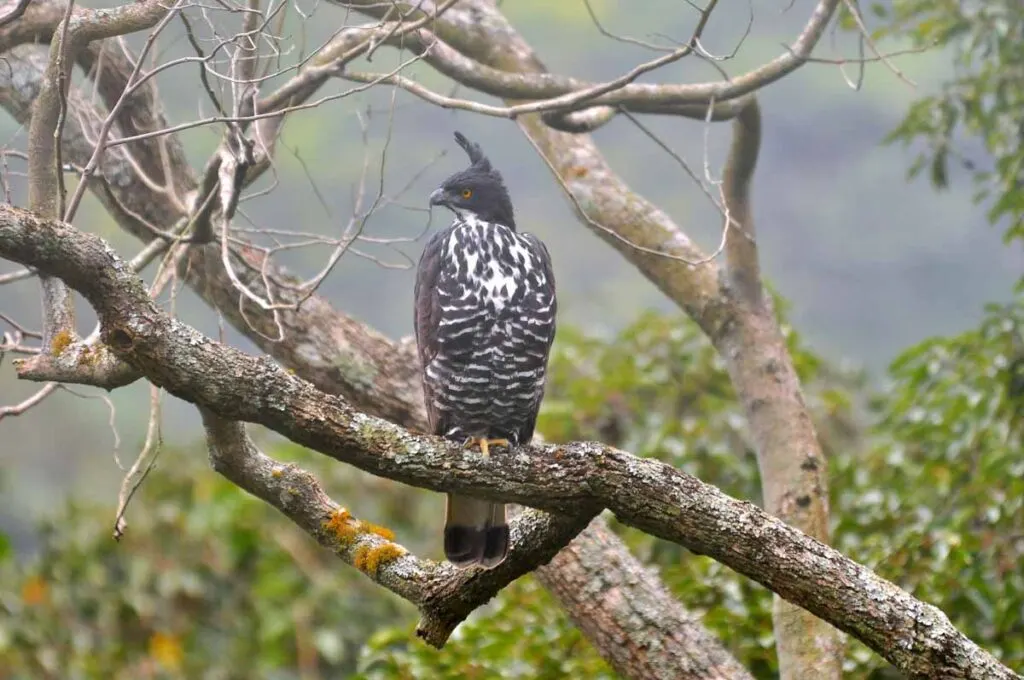
Blyth’s hawk-eagle is a medium-sized eagle (19.69 to 23.62 in, and roughly 1.83 lbs.) with dark gray to black head, back, and wings.
They have a white underpart and neck, with black spots and bars.
They have broad, rounded wings (between 3.28 and 3.77 ft), which they use to circle and swoop down on prey, including birds, bats, lizards, and other small mammals.
These eagles occur in Borneo, the Malay Peninsula, Singapore, and Sumatra, where they inhabit open woodlands and forests (montane, wet, dry, etc.).
Although these “least concern” eagles have “hawk” in their names, they belong to an eagle genus.
They are called hawk eagles because they share certain adaptations with true hawks.
Mountain Hawk Eagle (Nisaetus nipalensis)
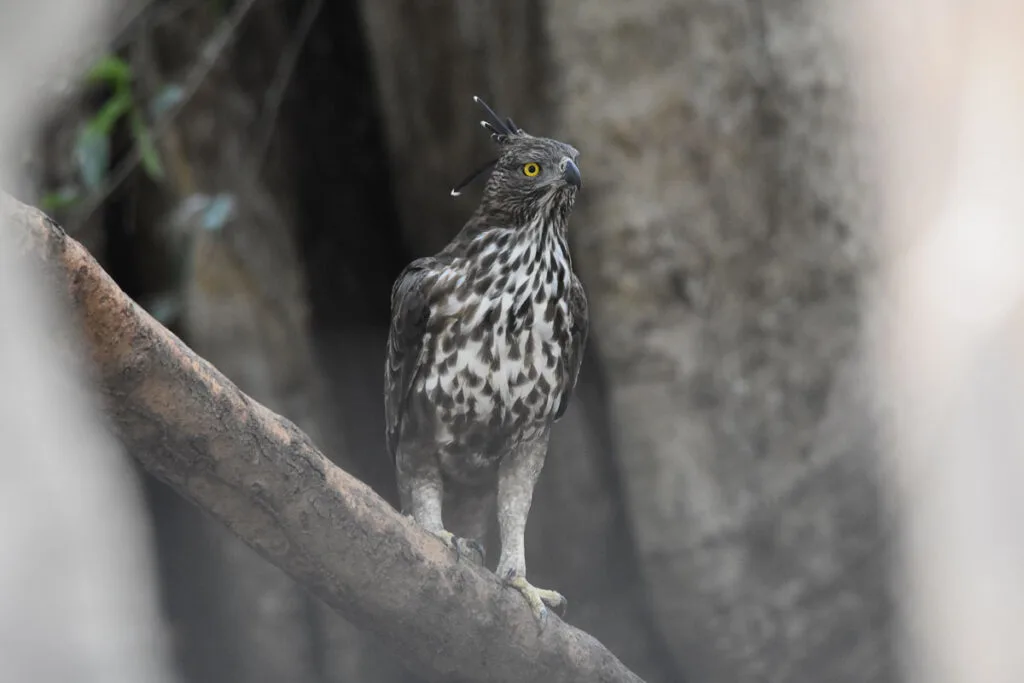
Mountain hawk eagles have (relatively) small heads, large wings (4.27 to 5.41 ft), and a large wedge-shaped tail.
They are dark brown on their back, head, and wings, pale underneath with brown belly bars and vertical, black throat streaks.
They have feathered legs, a three-banded gray-brown tail, and a white-tipped crest. Mountain hawk eagles grow between 26.38 to 33.86 in. and weigh 3.97 to 7.72 lbs.
Due to their body shape and proportions, mountain hawk eagles appear to be exceedingly large hawks. Aside from size, hawks lack the crest.
They inhabit forested hills and other forests (coniferous, deciduous, and mixed) between 3281 and 11483 ft, in Southeast Asia, from the Himalayas to Japan.
These eagles are opportunistic hunters, taking whatever prey is available (they often hunt from a perch). Prey includes birds, bats, reptiles, and small and medium mammals.
They are listed as “least concern.”
Ornate Hawk-Eagle (Spizaetus ornatus)
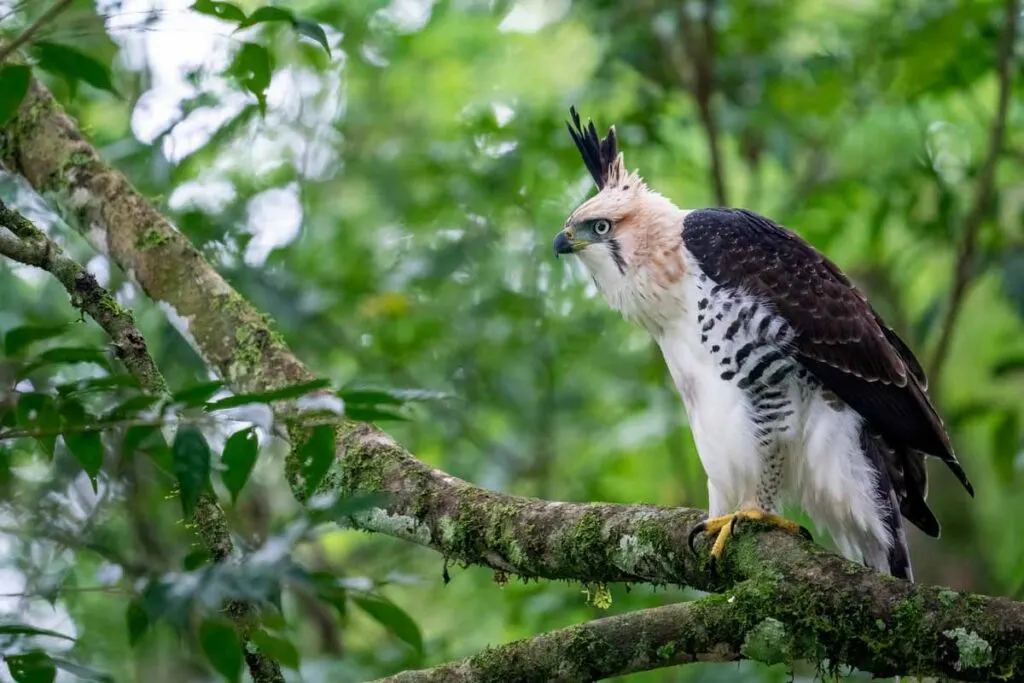
Ornate snake eagles are named after their “flashy”/decorative appearance. They have black crests, chestnut heads, sides of the neck, and breasts, and are white and barred underneath.
Their chin, throat, and breasts are white. They grow between 23 and 26 in (they weigh 2 to 3.5 lbs.). Ornate hawk-eagles have average wingspans of 3 to 4 feet.
They occur in tropical forests (and forest edges), lowland swamps, and open regions boarding forests at low to medium altitudes in Central and South America.
While their diet primarily consists of larger birds (up to 10 pounds), they also eat reptiles and small mammals (squirrels, hares, etc.), which they often hunt prey from a perch. These strong eagles catch prey up to double their weight.
These eagles are near threatened.
Ornate hawk-eagles raise and lower their crests when they are curious, excited, or alarmed.
Snake Eagle Types
Crested Serpent Eagle (Spilornis cheela)
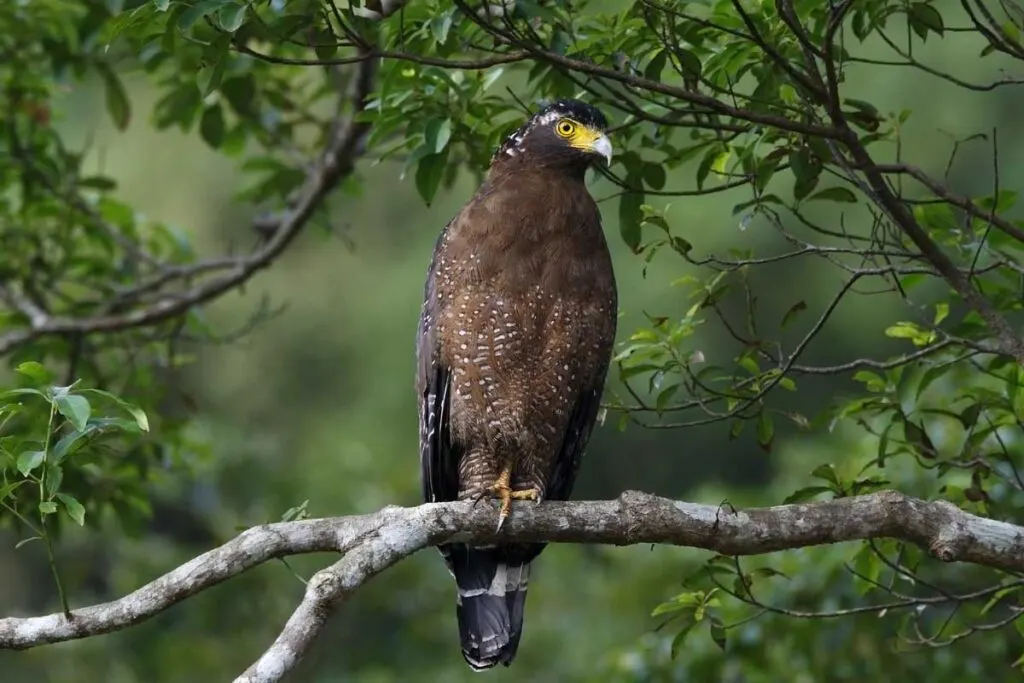
The crested serpent eagle is a large, heavy-set eagle. The white-tipped crest feathers give this type of eagle the impression of a large head.
When startled, the eagle “fluffs” the feathers around its head. They have a yellow “mask” and unfeathered yellow legs.
Most are between 19.6 to 29 in long, weigh 1.06 to 3.96 lbs, and have wingspans of 3.48 to 5.54 ft.
They have a rufous-brown body, white spots under the large rounded wing, and black tips on white flight feathers.
These eagles live up to 50 years and occur through most of Southeast Asia, East Asia, and the Indian subcontinent, where they occupy areas between sea level and 6562 feet.
They frequent agricultural fields and soar over densely-wooded hills and forests, mangroves, rocky hilltops, savannas, and areas close to villages.
Their preferred food is tree snakes, eels, frogs/toads, lizards, small mammals, and birds. These types of eagles hunt from a perch and ambush prey.
While mostly solitary or in pairs, they occasionally aggregate in groups of four or five, where they are quite noisy. Occasionally the crested serpent eagle lays eggs in other raptors’ deserted nests.
Their conservation status is “least concern.”
These eagles are a bit of a scientific conundrum; while some scientists believe that there are around 21 subspecies, others argue that some of the subspecies should be separate species of eagle.
Brown Snake Eagle (Circaetus cinereus)
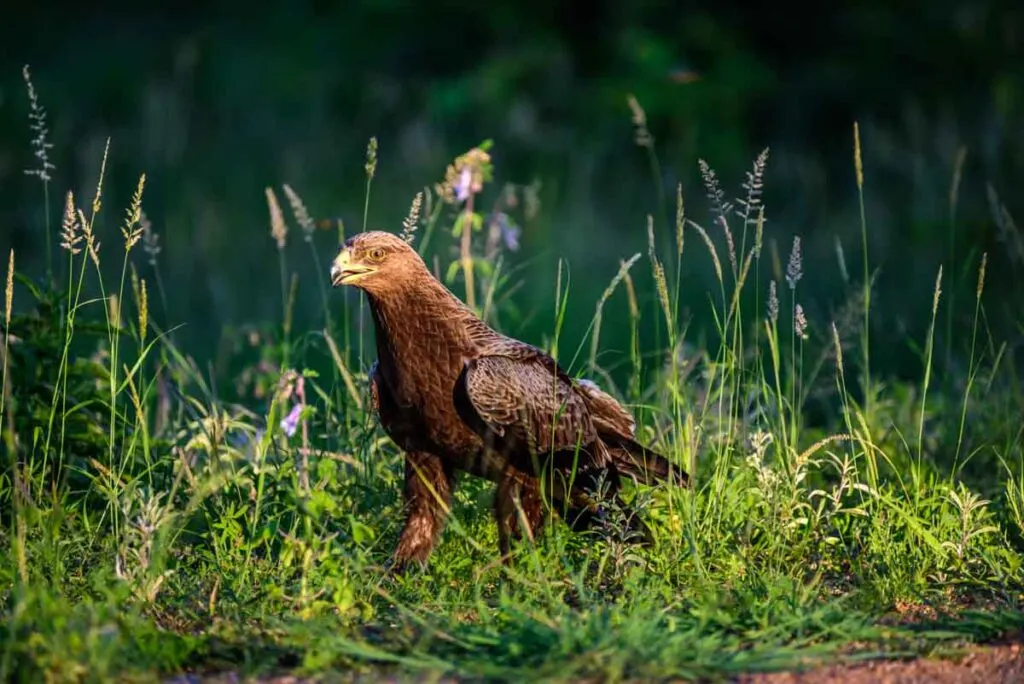
Brown snake eagles are medium-sized eagle types (reaching 28 to 30 in and weighing 3.31 to 5.51 lbs.). Brown snake eagles are the largest of the snake eagle types.
As their name suggests, they are predominantly brown. They have white on the upper breast, pale legs, and a black bill, and their tails are brown with white bands. Brown snake eagles have wingspans of 5.25 to 6.07 ft.
Their range includes West, East, and Southern Africa, where they inhabit plains, savanna, and semi-desert.
Although snakes are their primary prey/food, these eagles also catch birds and small to medium mammals, which they hunt from a perch.
Listed as “least concern,” these snake eagles often carry off 6 ½ foot snakes, including venomous snakes.
Once caught, they bite off the snake’s head before returning to their nests.
Fish Eagle Types
Steller’s Sea Eagle (Haliaeetus pelagicus)

The Steller’s sea eagle is the largest of the sea eagles, reaching 34 to 41 in and weighing 10.8 to 20.94 lbs. (the heaviest of all eagle types).
They have prominent yellow bills and are mostly dark brown. However, they have a white forehead, shoulders, tail, and thighs. These eagles have a wingspan of 6.56 to 8.2 ft and live up to 20 years.
Primarily occurring in Russia (in northeastern Siberia), some birds migrate to the Kuril Islands and Hokkaido, Japan. These birds are vulnerable.
You’ll find these eagles along rocky seacoasts and rivers, where they perch on cliffs or trees, waiting for (primarily) salmon and trout (capitalizing on abundant supplies during the spawning season).
However, they also eat crabs, puffins, small mammals, and carrion (including deer).
Occasionally, they stand in shallow water and “fish” for food. They often steal food from other raptors.
White-Tailed Eagle (Haliaeetus albicilla)
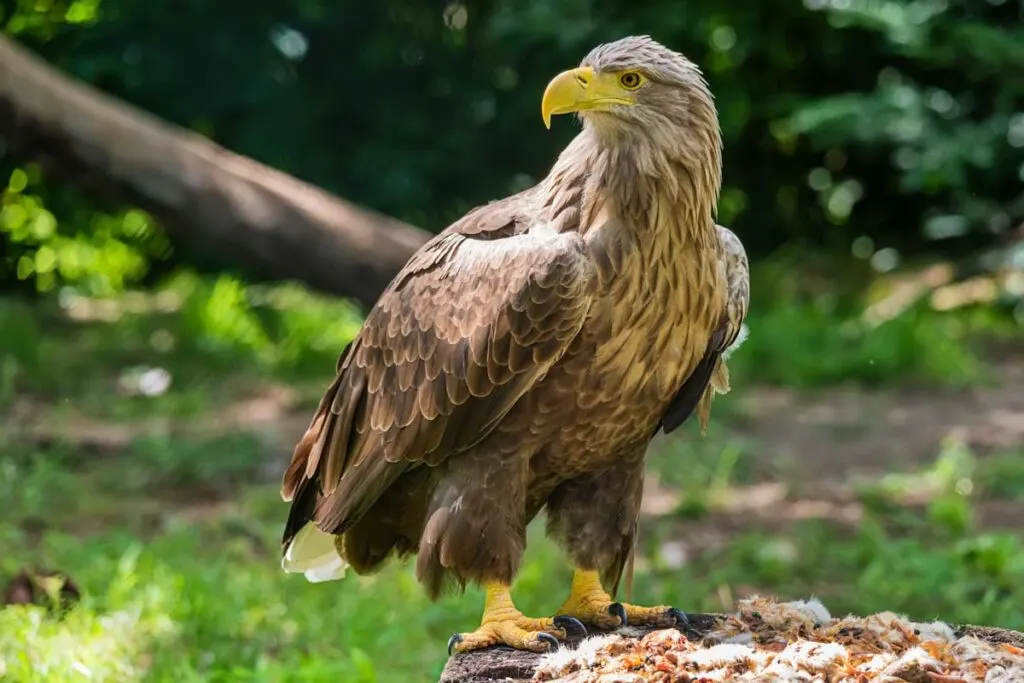
These large sea eagles have massive yellow bills, broad, straight wings (6.56 to 7.87 ft), and short, white, wedge-shaped tails. White-tailed eagles have dark brown bodies and pale heads.
These eagles weigh an astounding 7.71 to 15.43 lbs. and grow to 27.56 to 35.43 in. They are widespread, including Europe, China’s coastlands, Southwestern Greenland, the Middle East, and Russia (including Siberia).
White-tailed eagles occupy estuaries, lochs, and rocky coastlines where they eat primarily fish. However, they also consume carrion, other birds, rabbits, hares, and other small mammals.
When “fishing,” they glide low over the water and over before swooping down and grabbing a fish.
Although they are listed as “least concern,” they were locally extinct in England by 1918. Thankfully conservation efforts established a new population in Scotland by the 1950s.
African Fish Eagle (Haliaeetus vocifer)

African fish eagles are distinct in appearance, with a white head and chest, large yellow bill, brown bodies/shoulders, and black wings (between 6 to 8 ft).
These eagles grow between 25 and 30 in. and weigh 4 to 8 lbs. They can live up to 24 years.
African fish eagles are common throughout West, East, and Southern Africa. They are mostly found around various water bodies (coastlines, rivers, lakes, wetlands, etc.).
While their diet is primarily fish, they also eat flamingos (and other birds), reptiles, and carrion.
Although they may steal food from other birds, these eagles soar above water bodies (or perch on trees close to food sources) and swoop down to catch fish on the wing.
African fish eagles sound and look similar to bald eagles. Their call is one of the most recognizable among African birds (often called the “voice of Africa”).
They are the national bird in South Sudan, Zambia, and Zimbabwe and are listed as “least concern.”
African fish eagles have barbed feet that assist in catching and holding slippery fish.
Harpy Eagle Types
Harpy Eagle (Harpia harpyja)
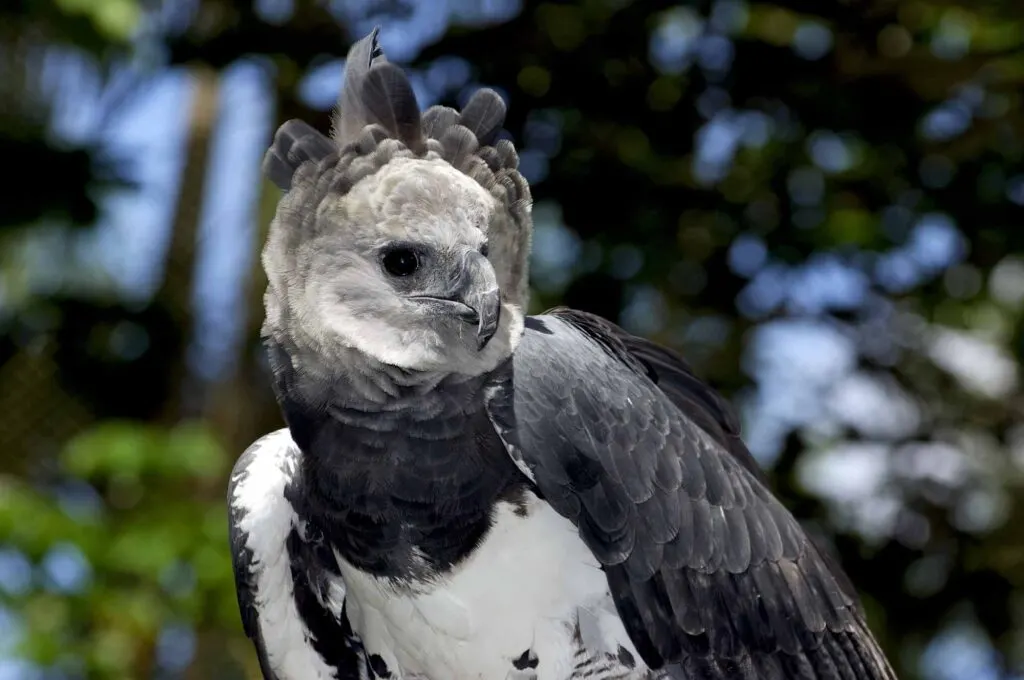
The harpy eagle is considered one of the largest birds in the world, at 2 ft 10 in to 3 ft 6 inches in length and 5 ft 9 in to 7 ft 4 inches in wingspan. It is the heaviest (8.5 to 20 lbs.), strongest, and has the largest talons (as large as a grizzly bear’s claws).
They have a gray head, dark gray to black back, wings, and breasts, with a white underside.
Harpy eagles have black and white bars on their wings (which reach up to 6 ½ ft).
Their legs are white with black stripes, and they have yellow feet. Their talons, beaks, and eyes are black or off-red.
These magnificent birds live up to 35 years in Mexico and Central and South America (as far south as northeast Argentina), where they inhabit rainforests. You’ll often see them perched on treetops.
Their (relatively) short wings help navigate between trees as they hunt other birds (macaws), iguanas, opossums, monkeys, and sloths.
Although they are the national bird of Panama, their conservation status is vulnerable.
Philippine Eagle (Pithecophaga jefferyi)
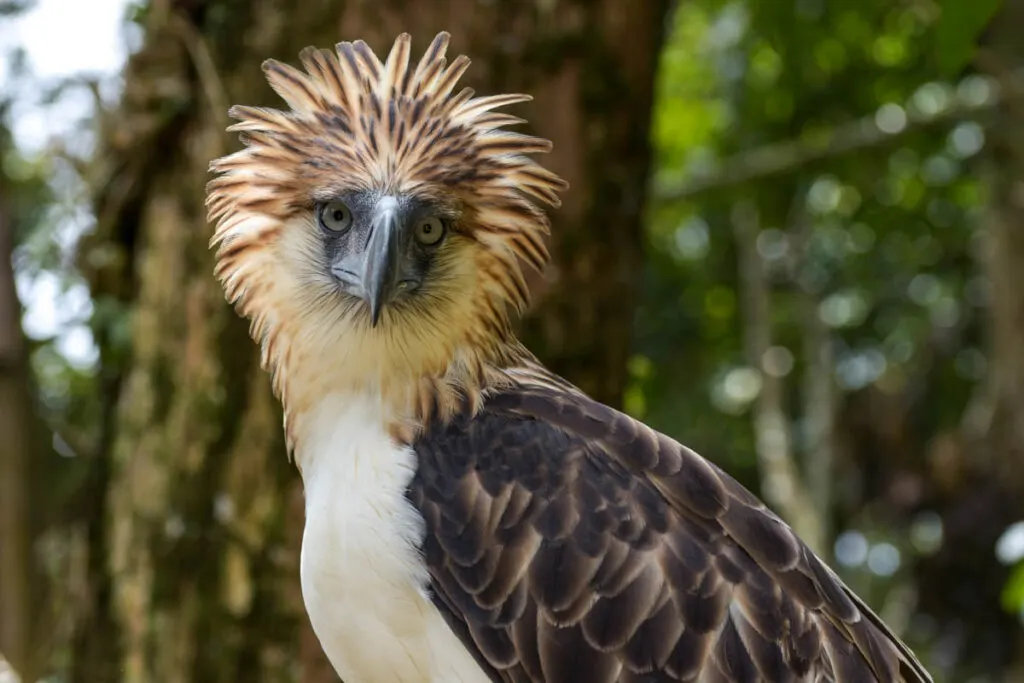
The Philippine eagle is a massive bird (between 33.86 and 40.16 in long, weighing 8.82 to 17.64 lbs.) with a dark face, cream-to-buff crown, and shaft streaks on elongated napes, creating a crest.
They have large dark-gray bills, yellow legs, and a pale gray iris. They’re white underneath and dark brown above.
Mostly solitary, they hunt either by remaining motionless on a branch and waiting or gliding from perch to perch (often down a tree) on 6.04 to 7.22 ft wings.
These eagles live between 30 and 60 years. They are endemic to the Philippine islands of eastern Luzon, Samar, Leyte, and Mindanao, where they frequent moist and montane forests and around rocky, steep areas from lowland to 5,906 feet.
Although called “monkey-eating eagles,” they have a wide prey variety, including bats/flying foxes, birds, palm civets, Philippine flying lemurs, reptiles, and monkeys. They also catch small pigs and dogs.
These critically endangered eagles are the national bird of the Philippines, and killing one could land you in jail for up to 12 years.
Like this article about the different types of eagles? Then share it on your Facebook!
